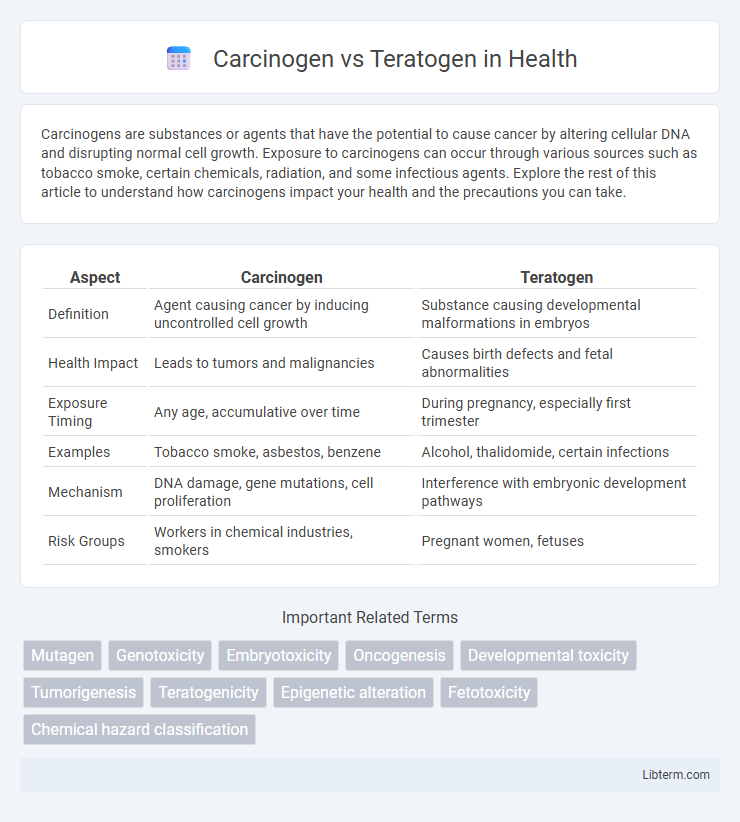Carcinogens are substances or agents that have the potential to cause cancer by altering cellular DNA and disrupting normal cell growth. Exposure to carcinogens can occur through various sources such as tobacco smoke, certain chemicals, radiation, and some infectious agents. Explore the rest of this article to understand how carcinogens impact your health and the precautions you can take.
Table of Comparison
| Aspect | Carcinogen | Teratogen |
|---|---|---|
| Definition | Agent causing cancer by inducing uncontrolled cell growth | Substance causing developmental malformations in embryos |
| Health Impact | Leads to tumors and malignancies | Causes birth defects and fetal abnormalities |
| Exposure Timing | Any age, accumulative over time | During pregnancy, especially first trimester |
| Examples | Tobacco smoke, asbestos, benzene | Alcohol, thalidomide, certain infections |
| Mechanism | DNA damage, gene mutations, cell proliferation | Interference with embryonic development pathways |
| Risk Groups | Workers in chemical industries, smokers | Pregnant women, fetuses |
Introduction to Carcinogens and Teratogens
Carcinogens are substances or agents that promote the development of cancer by causing mutations or disrupting cellular processes, while teratogens are agents that cause developmental abnormalities or birth defects during embryonic growth. Both carcinogens and teratogens can be chemical, physical, or biological in nature, impacting human health through different mechanisms. Understanding the distinct pathways and effects of these hazards is crucial for risk assessment and prevention in public health.
Defining Carcinogens: What They Are and How They Work
Carcinogens are substances or agents that cause cancer by inducing genetic mutations or disrupting cellular processes, leading to uncontrolled cell growth. These agents can be chemical, physical, or biological, and include tobacco smoke, asbestos, and certain viruses like human papillomavirus (HPV). Carcinogens work by damaging DNA or interfering with normal cell cycle regulation, increasing the risk of tumor formation and malignancy.
Understanding Teratogens: Mechanisms and Effects
Teratogens disrupt embryonic development by interfering with cellular differentiation, proliferation, and signaling pathways, leading to congenital malformations or functional deficits. Common teratogens include chemicals like alcohol, certain medications such as thalidomide, and environmental factors like radiation, which exert effects during critical periods of organogenesis. Understanding teratogenic mechanisms enhances prevention strategies by identifying vulnerable developmental windows and molecular targets for therapeutic interventions.
Key Differences Between Carcinogens and Teratogens
Carcinogens are agents that cause cancer by inducing genetic mutations or promoting uncontrolled cell growth, while teratogens are substances that cause developmental malformations or birth defects during embryonic or fetal development. Carcinogens primarily affect somatic cells leading to tumor formation, whereas teratogens impact cellular differentiation and organogenesis in the developing fetus. Exposure timing is critical; carcinogen effects often manifest later in life, whereas teratogen exposure results in immediate structural abnormalities during critical periods of pregnancy.
Common Examples of Carcinogens
Common examples of carcinogens include tobacco smoke, asbestos, benzene, and ultraviolet radiation, all of which are known to cause cancer by damaging DNA and disrupting cellular processes. These substances are distinct from teratogens, which specifically cause developmental abnormalities during fetal growth rather than triggering cancer. Exposure to carcinogens often results in mutations that lead to uncontrolled cell proliferation, highlighting the importance of minimizing contact with these hazardous agents in occupational and environmental settings.
Typical Teratogens in Everyday Life
Typical teratogens in everyday life include alcohol, certain medications like thalidomide and isotretinoin, and environmental chemicals such as lead and mercury. These substances interfere with fetal development, leading to birth defects or developmental abnormalities. Unlike carcinogens, which cause cancer by altering cellular DNA, teratogens specifically disrupt embryonic or fetal growth during critical periods of pregnancy.
Health Impacts: Carcinogens vs Teratogens
Carcinogens are substances that cause mutations in cellular DNA, leading to uncontrolled cell growth and cancer development, significantly increasing morbidity and mortality rates worldwide. Teratogens disrupt fetal development during pregnancy, causing congenital malformations, developmental delays, or miscarriage, with critical impacts on neonatal health. Exposure to carcinogens heightens long-term cancer risk, while teratogens primarily affect prenatal development, resulting in lifelong disabilities or fetal loss.
Routes of Exposure and Risk Factors
Carcinogens primarily enter the body through inhalation of tobacco smoke, ingestion of contaminated food or water, and dermal contact with hazardous chemicals, with risk factors including prolonged exposure, genetic predisposition, and lifestyle habits such as smoking. Teratogens commonly affect the fetus when pregnant women ingest drugs like alcohol or pharmaceuticals, inhale toxic substances, or absorb harmful chemicals through the skin, with heightened risk during critical periods of fetal development and maternal health conditions. Understanding specific exposure routes and timing helps in assessing potential harm and implementing effective preventative measures against both carcinogenic and teratogenic risks.
Prevention and Safety Measures
Minimizing exposure to carcinogens such as tobacco smoke, asbestos, and certain chemicals involves using personal protective equipment, following workplace safety regulations, and promoting smoke-free environments. Preventing teratogen-related harm requires pregnant women to avoid alcohol, certain medications, and environmental toxins, while ensuring regular prenatal care and nutritional support. Implementing strict regulatory policies and public education campaigns enhances overall safety by reducing risks associated with both carcinogens and teratogens.
Future Research and Public Health Implications
Future research on carcinogens and teratogens must prioritize identifying low-dose exposure effects and genetic susceptibility to better predict health risks. Advancements in molecular biology and toxicogenomics will enhance detection of early biomarkers, enabling targeted prevention strategies. Public health policies should integrate updated scientific evidence to improve regulatory standards and reduce the incidence of cancer and birth defects globally.
Carcinogen Infographic

 libterm.com
libterm.com